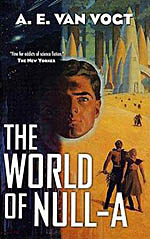
![]() charlesdee
charlesdee
1/22/2012
![]()
Science fiction writer A. E. van Vogt liked big ideas. In the 1950's he became head of fellow sf writer L. Ron Hubbard's Dianetics Institute, the secular precursor to the Church of Scientology. When Hubbard's institute failed within a year, van Vogt and his wife formed their own institute and kept it going for the entire decade.
Earlier, the big idea that captivated van Vogt was the Gerneral Semantics program of the Polish count Alfred Korzybski, a program defined in the count's 800 page self - published book Science and Sanity: An Introduction to Non-Aristotelian Systems and General Semantics. (1933). This was a grand system intended to make people think more clearly, reach better decisions, and create a better world. Much of General Semantics seems like common sense, but the insistence on its "science" is shaky and always prompted as many detractors as followers. Van Vogt was enthusiastically among the latter. Martin Gardner is among those who dismiss the enterprise as "pseudo-science," but there is a still an Institute of General Semantics in Chicago. Of course there is also an International Center of Theosophy, and London is home to the Swedenborg Foundation. Sorry to sound dismissive but I am.
True Believer van Vogt used Kozybski's ideas as the underlying philosophy of his breakthrough novel The World of Null A and two sequels, one of which has only been published in France. (Van Vogt, while not as popular as Jerry Lewis, is highly regarded in France.) The story originally appeared serialized in 1945 in Astounding Stories and was published, in hardback and to general acclaim, in 1948. Van Vogt revised the novel again and wrote a new introduction in 1980.
"Null A" is shorthand for non-Aristotelian, and in his 1980 introduction van Vogt lays out how integral Korsybki's ideas are to the novel. I will have to take his word for it. The novel reads like a dated sf adventure story involving an intergalactic plot to take over the Sol System. Our hero, Gilbert Gosseyn has lost his identity but is somehow central to the saving the earth. Clunky prose does nothing to help the storytelling. In his introduction, van Vogt makes a statement that is either poorly phrased or breathtaking in its hubris:
I cannot at the moment recall a novel written prior to Null-A that had a deeper meaning than that which showed on the surface.
A. E. van Vogt earned Grand Master status from the Science Fiction Writers of America in 1996, but his reputation has always had significant detractors. Damon Knight wrote a blistering evaluation of van Vogt in the 1950's that some say finished his career. Other writers, like Harlan Ellison and Philip K. Dick, write about how significant van Vogt was to the own, early immersion in science fiction. Perhaps today van Vogt is of "historical interest only," but I will not make so sweeping a judgment based on this one book. I am certain he earned his Grand Master status, but I am not tempted to delve deeper into his work.
http://www.potatoweather.blogspot.com